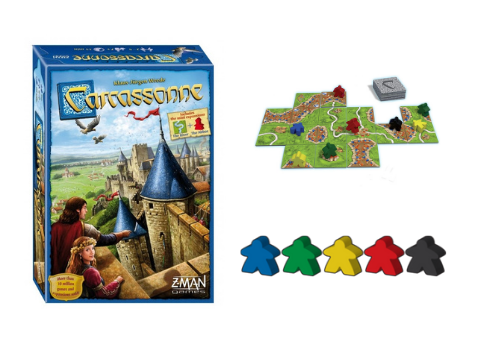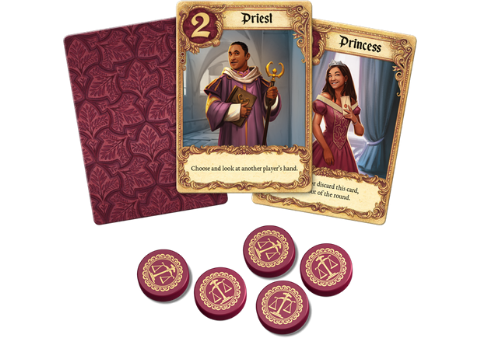For those that like interpret words, Codenames is a game you'll love. Here you can create teams to compete against each other. If you don't like fighting against each other, play in one team. The rules of Codenames allow you to choose whatever style of play you want. Try it out in all its variations.
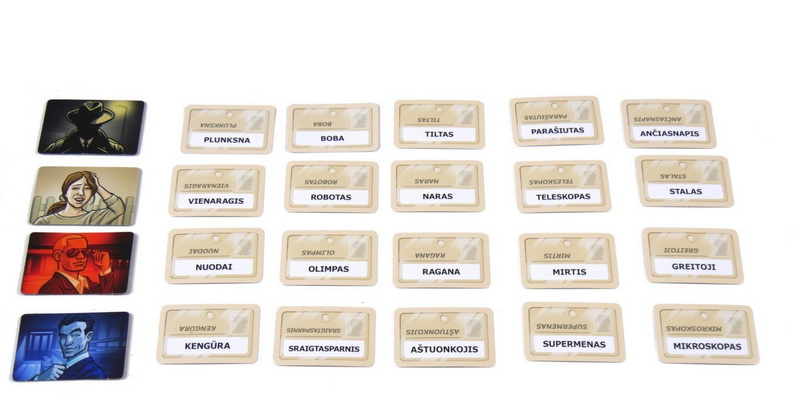
Other modern card games
Did you enjoy becoming agents and spies? You can try out similar roles in the next game - Spyfall. During the game, someone will become a spy. The other players will be ordinary people. And what is the goal of the game? The spy will have to keep who he is secret. And everyone else will have to guess which of the generations playing the game that spy is. What role will you play? And will you succeed in your task? Try your luck!
Frequently asked questions
❓ How long does it take to play Codenames?
Preparation time for the game: 1-5 minutes. The game itself lasts about 15-30 minutes.
❓ How many people can play Codenames?
According to the original rules, Codenames is recommended 4-8 people. But it can also be played by two or three people.
❓ From what age can I play Codenames?
Codenames is suitable for people from 14 years. Although you can accept younger players on your teams, as the rules are not too difficult.
Codenames game - rules
Preparing for the game
Codenames is usually played in teams, so it's best if at least four people are involved and can form two teams.
There are also variants for two or three players. You will find them here.
One player from each team becomes that team's Secret Agent Commander. Both Secret Agent Commanders must sit on one side of the table. On the other side of the table, the intelligence agents of that team shall sit opposite the commanders.
25 cards of any nicknames (words) are chosen at random. They are placed side by side on the table in a 5×5 square.
 Cipher cards
Cipher cards
Secret agent commanders take one cypher card. This card reveals the identities of the cards on the table. The commanders place their cards on the stand in front of them. The card can be placed in any way - it doesn't matter where the top or bottom of the card is. The important thing is that the card is not seen by intelligence agents.
The layout on the code card shows which cards are arranged on the table. The blue team has to guess the blue words and the red team has to guess the red words. The yellow squares are random passers-by. The black square is the killer, who is best left untouched.
Each font card has four lights on the edges. Whichever colour the light is on the drawn card, that team starts the game. The first team guesses 9 words and the second team guesses 8. The first clue is said by the team that starts the game.
Agent cards:
- 8 red agents
 ;
; - 8 blue agents
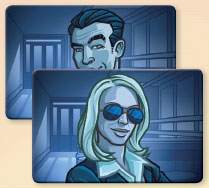 ;
; - 1 double agent
 ;
; - 7 innocent bystanders
 ;
; - 1 killer
 .
.
There are 8 red and 8 blue agent cards in total. They need to be separated into two piles according to colour. Each agent places a stack of agent cards of his team's colour in front of him.
1 double agent card. This card is awarded to the team that starts the game. The card must be placed face up with the team it belongs to.
7 innocent bystanders and 1 murderer. Place these cards in the middle of the table so that they are within easy reach of both commanders.
Game progress
Played in turns. The team whose coloured lights are drawn on the edges of the font card starts.
How to give a hint?
The commander of the secret agents comes up with a clue that relates to a few words that are coloured by that team on the font card. There is also a number to say. It indicates how many aliases (cards) are associated with the given clue.
Example. the two command words are varna and hawk. You say Bird: 2.
You can think of a clue for one word, but it's much more fun when the clue fits two or more words.
One word
A hint can be only one word. No sentences or word combinations. A clue cannot be a word on the table. If something is left out, that card is covered. You can then use a clue that you could not use before.
How do I get in touch?
The Commander of the Secret Agents gives a hint to his intelligence agents. Then they have to guess. They can confer among themselves, but it is important that the commander of the agents does not join in the conferring. A formal guess is announced when one of the intelligence agents touches a card with a word on it on the table.
- When an intelligence agent touches a card belonging to his team, the card is covered by an agent card of the same colour. The next word can then be guessed from this clue;
- When an innocent bystander card is touched, the innocent bystander card is covered and the team's turn is over;
- If a card from another team is touched, it is covered by a card of the other team's colour. The turn is then over;
- When the killer's card is touched, it is covered by the killer's card. The team immediately loses.
Important: If you are a commander of agents, make sure the clue is not related to a word on the assassin's card before you say it.
Number of predictions
Intelligence agents guess at least once during each move. If they do not guess, their turn ends. If they guess, they can guess again.
If a team no longer wants to guess, it can stop doing so at any time. It is important to remember that you have to guess once.
Example:
- Red team's first clue - Bird: 2. It was chosen duck card. Another option was varna. Because duck - innocent bystander card, team's turn is over.
- The blue team correctly guessed two words during their turn.
- The red team continues playing. Hint - River: 3. The Intelligence Agent selects a card - Amazon. It is covered by the red agent card, which means the team can guess again. Players now choose a card - loop. They guess again.
- The team does not come up with a third word, so it chooses a card - varna. That was an earlier hint. Since the card belongs to this team, it is covered by the red agent card and you can guess again. The intelligence agent can try to guess the third word related to the river or the second word related to the bird. If the team has no ideas, it can simply end its turn.
Only one additional guess can be made. If the Agent Commander says 3, you can make four guesses. If the agent says 2, you can make three guesses. The other team plays when the previous team makes a mistake or says it has finished guessing.
Order of play
Each turn, the commanders of the secret agents give clues to their team. At least one word is covered each turn.
End of game
When a team has covered all its words, the game is over and that team wins. You win even if the other team chooses your last word. It is also possible to end the game even earlier by touching the killer card.
Preparing for the next game
The next game is easier to prepare for than the first. Simply turn down the agent cards and turn the 25 cards on the table face up.
Codenames game - useful tips
Punishment for bad innuendoes
- If the Agent Commander gives the wrong clue, his team's turn is immediately ended. As a penalty, the other team's team leader may place one agent card of his colour on any card.
- When a bad hint goes unnoticed, punishment is avoided.
How not to give yourself away
- The commander of the secret agents cannot give himself away. He cannot take any card for cover until a specific word is touched. Even if it is touched, the font card must be examined carefully and only then the cover card taken. If the word guessed is not the word that was in mind, there is no need to pretend that the clue was intended for someone else.
- Intelligence agents have to look only at the cards when guessing, or confer with each other. No contact with the commander of the undercover agents, even eye contact is preferable.
- When the clue is just one word and no additional clues, eye contact, winks, etc., then you are playing by all the rules.
Why do I need a timer?
- The hourglass is only used when a member of another team decides that someone is spending too much time guessing. The clock is then flipped over and the guessing has to be finished before all the sand crumbles to the bottom of the clock.
- You can even flip the hourglass while playing. Simply, if you find that you are taking too long to think of a clue, then say something about the hardest word and then think of clues for your other cards.
Correct clues
As people and teams differ, you should experiment with the choice of cues and the rules that apply to them.
Fixed rules
Which clues are bad?
- The hint should only be about the meaning of the words. The first letter or the number of letters should not be mentioned;
- Letters and numbers can be used when they have meaning. X:1 means equation, o Four:2 means Square and Quartet.
- The number that indicates how many words correspond to that clue cannot be used as a separate clue.
- Fruit: 8 cannot match these words: pear and octopus.
- You must play in Lithuanian. A clue cannot be a translation of a specific word on the table.
- No other form of the word on the table may be used.
- until the word Press not covered, you cannot say Printed from:, nuospauda, imprint via printer.
- You may not use the collapsed part of a word on the table.
- When we see on the table tie, we cannot say neck, collar, the tether via bind.
Homonyms and spelling
- Homonyms are words that are the same but mean different things.
- Clue ring you can use for the following words: hand and Princess or Rose and Nakvish.
- Sometimes a hint can be said in a casual way.
- Clue s-e-k-t-iwhen you need to guess a word spy. Otherwise, the player may think you are saying cover.
- A hint must be given verbally when someone on the team asks for it. If you can't do it, ask the other team's Secret Agent Commander for help.
Tip: It's not only when playing with homonyms that it's important to say it in the written word. You can say it when the environment is noisy or the accent interferes with the correct pronunciation.
When words are pronounced the same but spelled differently and have different meanings, they are considered different words.
Don't be too strict
When words are similar, they don't necessarily have similar meanings. Example: hint The gang does not relate to the word at all Smuggling. If you are in doubt about whether you are giving the right clue, consult the commander of the opposing secret agents. He will either agree with your planned clue or disallow it. It is important that the scouts do not overhear what you are saying.
Flexible rules
It is up to the teams to decide whether the clues are correct and meet the requirements.
Compound words
Sometimes it is impossible to describe something in one word. Example: ivory, white rows. Teams agree on whether to use multiple definitions. But it is important not to fantasise, i.e. space squid cannot be a hint for words moon and octopus.
Checks words
When verbs are used for clues, they can be compound words. It is up to the teams to decide whether to use them. Example: Vytautas the Great, The Three Musketeers via Los Angeles.
But again, we cannot fantasise. Example: Liepa Lee cannot be used for words tree and China.
Acronyms and abbreviations
Commands pair up or use abbreviations in hints. Example.: USA, UAB, CIA.
Homonyms
Teams can use homonyms if they wish. Example: the leader of the agents gives a hint found at for a hypothetical word log.
Rhyming words
It is possible to use rhyming words. It is important not to betray to the team that the clue this time is rhyming with the predicted word. Example: hint back to back rhymes with word was. But a hint back to back with word gysla does not apply. The words just sound similar, but such a hint could mislead scouts.
Hint from experienced players: zero
You can use the number zero, which indicates how many cards are associated with the clue. Example: bird: 0. In this case, none of the cards will be related to this clue, but you can guess as many times as you like. It is important to guess at least one word if you want to go further.
Hint for experienced players: unlimited
When there are a few words left with the previous clues, you can say the word unlimited instead of the number, which refers to the number of cards. Example: Bird:unlimited. The number of guesses then becomes unlimited. This option has the disadvantage that the scouts do not know how many words are related to this clue.
Codenames for two players
- Teams are not formed when playing with two players. In this case, you need to defeat a fake (imaginary) opponent.
- The word cards are placed on the table in the usual order. One player becomes a scout, the other a commander of secret agents. In this game, as in the regular game, both suits of agent cards are used.
- You need to choose the font card that matches your team's colour, as you are the only one playing, so you have to start the game first.
- The moves are carried out in the normal order. It is important to avoid opponents and killer cards.
- During the other team's turn, the leader of the secret agents must take one of their agent cards and cover a word with it. He can decide which word it is.
- A team loses when it hits on the killer card or when all the opponents' cards have covered their words.
- If your team wins, mark your points. You get as many points as the number of opposing agents' cards left.
Scoring: 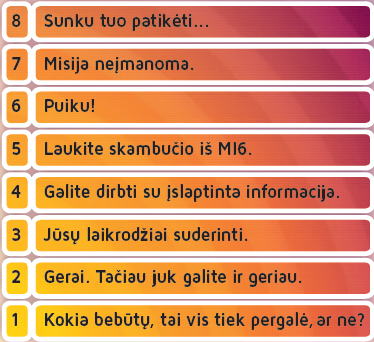
Note: The result will be affected by the number of guesses you make per turn and the number of opponent agent cards you put on the words during your turn.
Codenames game for three
When there are three players, they can choose between two game options:
- 2 secret agent commanders and 1 intelligence officer;
- 1 commander and 2 scouts.
You can choose any game. But if two people want to compete as leaders of agents, then they need one and the same scout to support both sides.

